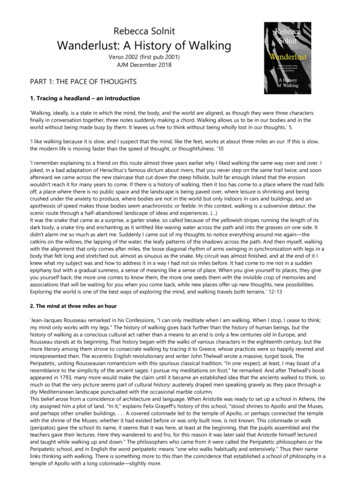
Transcription
Walking on Eggshells: Strength of a DomeGrades 3-5Meet Today’s ENG HERO!Ayan Sadhu – Assistant Professor with Western EngineeringDr. Sadhu completed his B.Tech at Jadavpur University, his M.Tech at the Indian Institute ofTechnology (IIT) Kanpur, and his Ph.D at the University of Waterloo. His Ph.D was in the field ofstructural health monitoring. Before joining Western University as an Assistant Professor, Dr.Sadhu was an Assistant Professor at Lakehead University and he worked on the Dynamicsteam at General Electric (GE) Aviation after he completed his M.Tech. His work focuses ondeveloping remote and autonomous techniques to assess faults and mitigate failures instructures.To learn more about Dr. Sadhu visit: https://www.eng.uwo.ca/civil/faculty/sadhu a/index.htmlLearning Goal: Students will learn about the strength and value of the dome shape and design and build their own dome.Curriculum Connections: Grade 3 – Strong and Stable Structures; Grade 5 – Forces Acting on Structures andMechanismsMaterials Needed:For Test 1: 2 eggs Pin Bowl Pen Tape Scissors or an exacto knife Books (to use as weights) Optional: toothpick Optional: straw
WALKING ON EGGSHEELS: STRENGTH OF A DOMEFor Test 2: 3 eggs Egg carton Plastic plate Bucket to hold water Water to add to bucket (to use as weight)For Building Your Own Dome, choose from the following materials: Cardboard Straws Hot glue or other type of glue Paper Tissue Paper Pipe cleaners Scissors Paper or notebook PencilEngineering and Science Connections:If you look around a city, many of the buildings you see will be built with different materials, are different sizes, andare structurally different. Next time you are surrounding by buildings, look for the different shapes you may seebuilt into the structures. Those shapes could be triangles, arches, rectangles, domes, and others!Today’s activity investigates the strength of domes.What is a dome?A dome is a curved roof enclosing a circular space. It is almost like a 3D arch. There are no angles and no corners in adome. Domes are particularly impressive because they can enclose a huge amount of space without a single column.Domes in Real LifeDomes are part of the natural world. For example, think about the shape of a turtle shell or the back of a beetle. Theyare also present in newly built structures like the Toronto SkyDome where the Toronto Blue Jays play or at the EpcotCenter at Walt Disney World.Spend some time researching these famous domes or any others.
WALKING ON EGGSHEELS: STRENGTH OF A DOMEDomes were even used by ancient cultures to support heavy loads. A very famous dome is the Pantheon Dome inRome, Italy. The Pantheon was a temple built by the Romans nearly 2000 years ago! Even though it was built so longago, it is regarded as one of the most important structures in the world because of how large the dome is and howlong it has been standing. You can check out the link in the Video Recommendations section below to watch a videothat provides more information about the Pantheon.Why are domes so strong?Domes are so strong because of their shape. The dome shape distributes the weight/pressure/force evenly over theentire dome shape, which reduces the load on a single point.LoadWe normally think of eggshells as brittle or that they tend to break easily. But actually, eggshells are quite strong ina lot of ways because of their dome shape. You will get the opportunity to test this out in today’s activity.Video Recommendations:The Pantheon - Under the Dome https://www.youtube.com/watch?v -aDhzQMIGCYHow strong are domes - from Fun Kids Inspiring Engineers https://www.youtube.com/watch?v D8h2DL-gWg8Activity:The activity today is broken down into 2 parts: a testing part and a design challenge part. There are 2 options for thetest, you can try both or you can choose to try 1. Note, Test #2 is less labour intensive because Test #1 requiresblowing out eggs, which can be difficult.Test #1:1. Carefully wash the outside of 2 eggs in warm water.2. Poke a tiny hole at the narrow end of one of the eggs with a pin.
WALKING ON EGGSHEELS: STRENGTH OF A DOME3. Flip the egg over and poke a hole at the other end of the egg with a pin. Use the pin or a toothpick to makethis hole slightly larger. This will be the hole that the egg contents will come out.4. Cover both holes of the egg with your fingers and gently shake the egg to break up the yolk and loosen theegg contents. Another option is to stick a toothpick in the hole at the wider end of the egg and move it upand down to loosen the egg contents. Loosening the egg contents will make them easier to blow out of theegg.5. Place the straw over top of the hole at the narrow end of the egg. You may want to cut the straw so it is notquite as long. Using a straw is safer but you can also put your mouth against the egg. Just be sure not toingest any raw egg.6. Blow into the straw and the egg contents should come out the hole at the other end of the egg. Be sure to dothis over top of your bowl to avoid making a mess.7. Continue blowing into the straw until the egg is empty.8. Carefully wipe away any raw egg that is on the egg shell.9. Repeat steps 2-8 for the second egg.Note: if you are having trouble blowing out your egg, you can refer to this video which may help:https://www.youtube.com/watch?v Jg3AVMNssiE10. Stick tape around the middle of one of the eggs. Repeat for the second egg.11. Mark the center for cutting the egg in half. Repeat for the second egg.12. Carefully cut along the line you drew, cutting through both the tape and the egg with scissors or an exactoknife. Repeat for the second egg. You should end up with 4 half eggshells that are all the same height.
WALKING ON EGGSHEELS: STRENGTH OF A DOME13. Arrange the 4 half eggshells in a rectangle shape.14. Slowly place a book on top of the shells.15. Continue adding books on top to see how many books your eggshells can support!Test #2:1. Cut out 3 egg slots from an egg carton.2. Place an egg in each egg slot.3. Arrange the eggs in a triangle shape.4. Place a plastic plate or book or something similar) on top of the egg triangle.5. Place a bucket on top of the plate.6. Slowly add water to the bucket to see how much weight the eggs can support!
WALKING ON EGGSHEELS: STRENGTH OF A DOMEDesign and Build a Dome:1. Research different domes that exist today. Your research will help you on the next step when you designwhat your dome will look like.2. Using your pencil and paper, draw out a design of what you want your dome to look like. Consider thematerials you have available and how big you want it to be. You may also want to build your dome onto acardboard base.3. Once you’ve finished designing your dome, begin building your dome with the materials you have available.Note, the pictures included below are meant to help you brainstorm if you are stuck, you do not need tobuild your dome this way.4. You can even try testing your dome after you have built it to see how much weight it can hold.What Did You Learn? Were the eggshells stronger or weaker than you expected?What other examples of domes do you see in nature? Why are domes so strong?Future Learning Try researching geodesic domes. Does this make you want to change the design of yourdome?What other materials could you use to build your dome?Share your creations!We would love to see what you made. Email as at discover@uwo.ca or tag us on social media.Instagram: @westernuengTwitter: @westernuengFacebook: @westernuengThanks for discovering with us!
14. Slowly place a book on top of the shells. 15. Continue adding books on top to see how many books your eggshells can support! Test #2: 1. Cut out 3 egg slots from an egg carton. 2. Place an egg in each egg slot. 3. Arrange the eggs in a triangle shape. 4. Place a plastic plate or book or something similar) on top of the egg triangle. 5.










